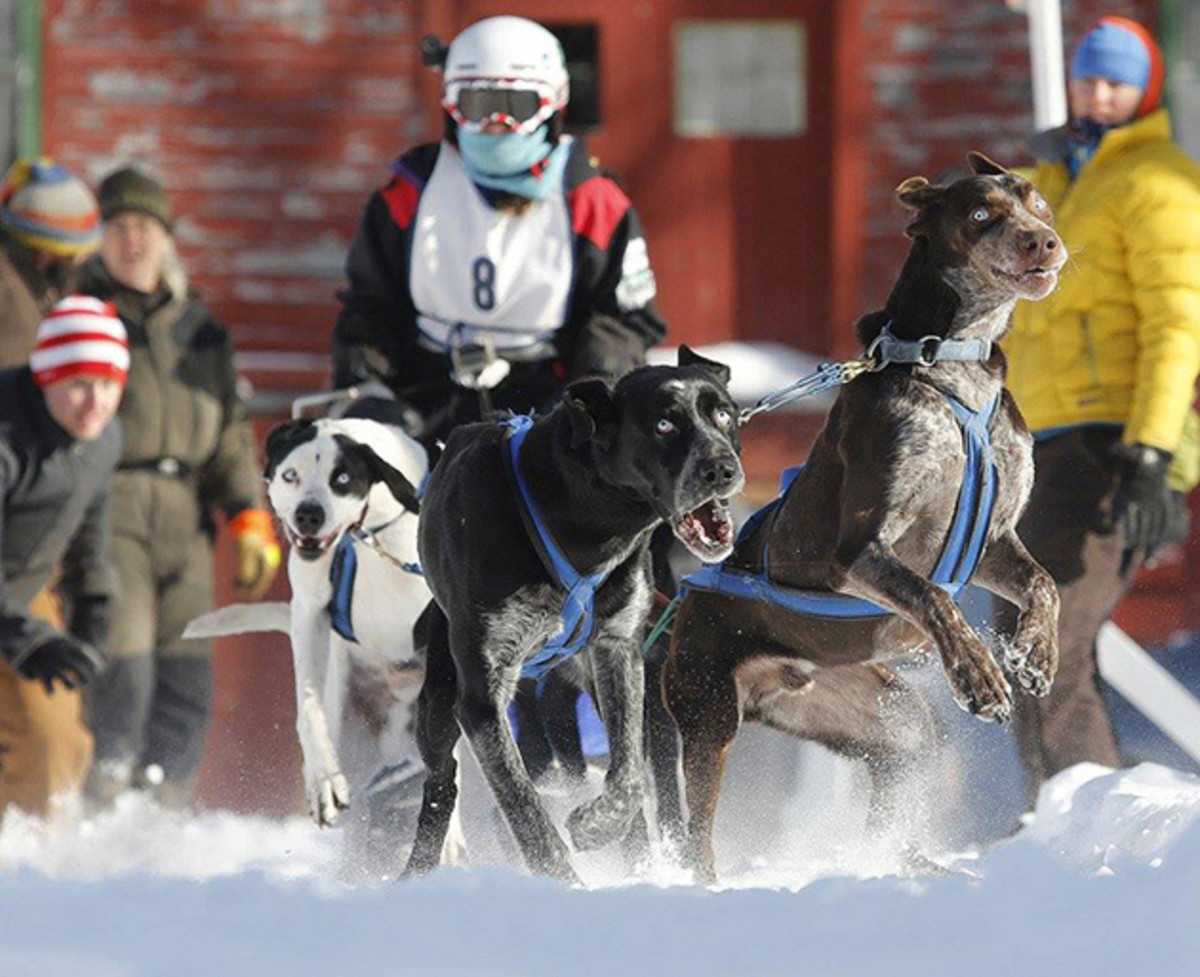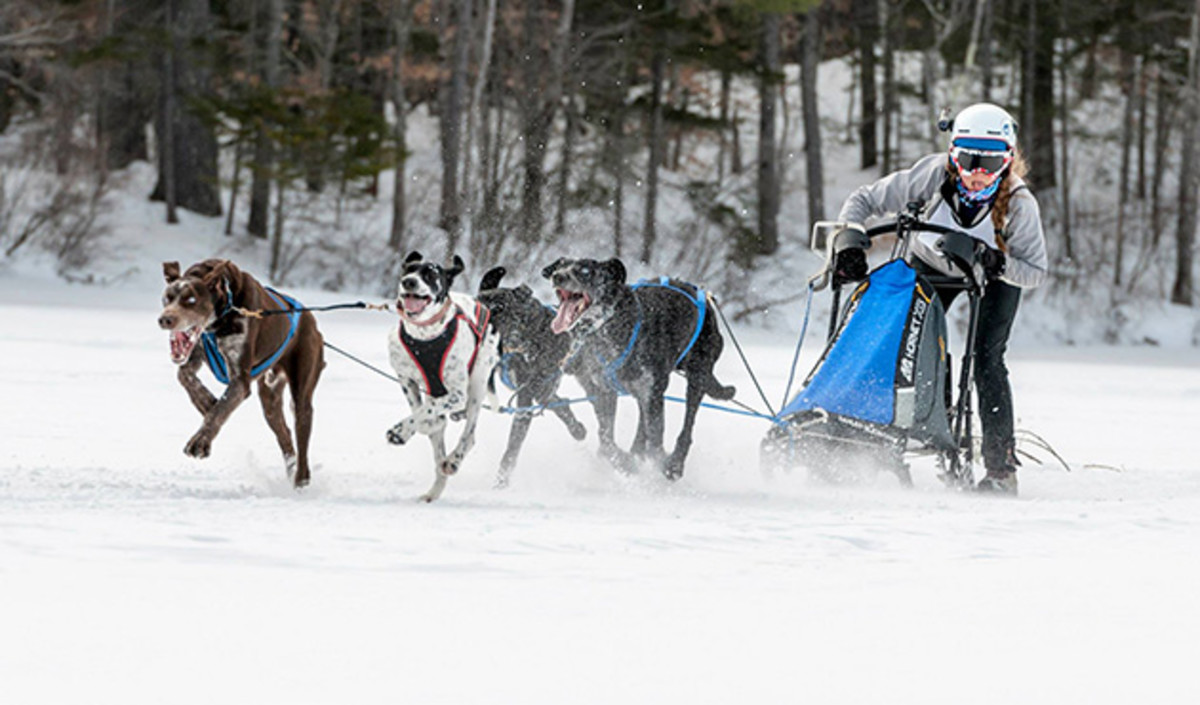Born to Run: Sprint sled-dog racing is fast and furry-ous

The four dogs hitched to Lily Stewart’s high-tech, 22-pound Danler Hornet racing sled look strangely out of place. They are not your stereotypical sled-dogs—the furry Alaskan huskies most of us envision traversing the Alaskan tundra in the famed Iditarod. Instead, they look more like some big old hound dogs you’d expect to be guarding your crazy uncle’s illegal moonshine still.
The dogs are a carefully bred mix: part husky, part German shorthaired pointer, and sometimes part greyhound. When their handler releases them, the hounds—Grinder, Chess, KT, and Endo—surge in unison, accelerating in a blink of an eye to hit top speeds of near 30 mph, a 16-legged bullet train.
The dogs appear possessed. In some ways, they are.
“They love having a job, a purpose,” says the 18-year-old Stewart, of Ipswich, Mass. “The speed is exhilarating, and the competitive nature of the sport is really addictive too.
“It’s like the NASCAR of the animal kingdom. Standing at the start line behind the runners with a team of powerful animals in front of you makes you feel invincible.”
Some might suspect Stewart is just a tad possessed as well.
“You definitely have to love winter,” she says, laughing. “When most kids my age are sleeping in to 10 a.m. on the weekends, snuggled up in covers, I’m waking up at 6 a.m. and stumbling outside into minus-40 temperatures. It’s totally worth it though, and I wouldn't trade those freezing days for a single day at the beach.”
***
There are many ways to describe pandemonium. For sprint sled-dog racers, it’s lining up a dozen or more four-dog teams at the start of a five-mile course, and letting them loose. Imagine, 48 hounds connected by 48 lines, yelping and straining, all vying madly for the same narrow track of snow.
Yet, amid the mayhem, Stewart finds an odd sense of calm, not unlike the proverbial eye of a hurricane.

“It’s like getting in this extreme zone, or flow state, where you’re just hyper-focused on the dogs and on the trail,” says the 5' 3", 100-pound Stewart, who won a bronze medal at the 2013 world championships in North Pole, Alaska. (A helmet cam video of that race can be seen here.) “You're really working to shave every single second off.
“Obviously, I love it. It’s just incredible to see a pack of animals work together, knowing that they want to win just as badly as you do.”
The world of sprint sled-dog racing is worlds apart from the multi-day events that most people associated with the Iditarod (won last month by Virginia native Dallas Seavey, in a time of eight days, 18 hours, and 13 minutes). Sprint events are held throughout the northern United States and Canada (“We typically want to go to Quebec,” says Stewart. “That’s where all the big cheeses are.”), where weather is always a wild card. Prize money is minimal. Most racers agree that they do it for simple reasons: A love of the sport, and a love of the animals.
Asked what the attraction of the sport is, Ken Davis of Twig, Minn., says simply, “The dogs, and then again the dogs.”
Adds Davis, “It’s about doing chores no matter what the weather, and you are still smiling because the care of the dogs is more important than anything.”
That sentiment is repeated often among racers.
Lance Armstrong in exile is restless, feisty and . . . underappreciated?
“Dog sledding is a passion of mine for several reasons,” says Amy Cooper, who runs a small kennel in Holmen, Wisc. “First and foremost, I absolutely love working and living with dogs. They’ve always been and always will be a huge part of my life. They are part of my family and are my best friends. Second is the challenge of developing a winning team. There are so many components involved, and I love the challenge of trying to put it all together.
“Third, I am a very competitive person by nature and have found that my dogs seem to be too. So we all get a huge thrill out of racing.”
Most sprint races, whether time-trails against the clock or mass-start events, are between five and 14 miles, lasting anywhere from 15 minutes to just over a half hour. Even the dogs are different. Very different.
“It’s like comparing a 5K runner to an ultra-marathoner,” says Stewart. “My dogs do the 5K version of sled-dog racing. We’re going 20, 25 miles an hour, for five to six miles.
“The dogs that do the distance racing, they’re bred to do that,” she says. “They love to go far at a nice, comfortable, eight- to 10-minute-mile pace. That’s what they love to do, trotting along in the snow in their pack. Our dogs wouldn’t love doing that. They want to go hard and fast and race all their friends to the finish line. And they want to win.
“In the sprint racing, the hounds become a lot more prevalent, just because they’re faster, and they have shorter coats, so they don’t overheat as much over the shorter distances.”
***
Sprint mushers also refute the charges that animal rights activists often levy against the sport, including that the dogs are abused.
“Like horse racing, you’re going to have people in this sport who don’t treat their animals with the same level of respect that the majority does,” says Stewart. “But you have pet owners around the country who don’t either. So it’s not fair to say that because somebody treats their pet poorly, no one in the United States can own a dog. It’s the same thing.”
On the contrary, sled-dog racers say their animals are typically treated exceedingly well, because that’s the only way they’ll reach their racing potential.
“If you talk to any musher, they’ll tell you that it’s cruel to not let these dogs run, because it’s what they’re bred to do,” says Stewart. “You can never force a dog to run. That’s not something we’re capable of. A dog will either run, or it won’t run.

“A lot of people who talk out against it have never actually been to a sled dog race. So they’ve never actually seen the excitement in the dogs, the pounding of the harnesses, and the interaction between the musher and the dog.”
That interaction places an enormous emphasis on caring for the dogs. Stewart and others say caring for the dogs is their first and last concern. The needs of the musher are secondary.
“There are so many misconceptions about the sport I could write a novel,” says Jocelyn Bradbury of Oxford, Maine, who kennels the dogs that Stewart races. “One of the biggest is that our dogs are too skinny. Have you ever seen an overweight track star? These dogs are athletes and are at their optimum weights.
“It would be a disservice as well as potentially harmful to them to keep them overweight and out of shape. Barring illnesses or unforeseen circumstances, sled dogs live to ripe old ages. Because they are kept in shape their whole lives and fed top-notch diets, they lead happy healthy lives well into their teens.”
You won’t find these dogs at the Westminster Dog Show, because they don’t fit neatly into any breed recognized by the American Kennel Club.
“Breeding is a science and an art,” says Bradbury. “These dogs do not belong to a breed group, and are evaluated on performance and not on looks. We don’t care about height at the shoulder, ear set or eye color. Top performing dogs are bred to top performing dogs and the real judging happens at the races.”
Stewart agrees.
“They are talented athletes who know their jobs, but also love people and attention,” she says. “It’s important to have a close bond with the dogs. This sport is all about the trust between dog and human, and the best racers are those who have that special connection.”
